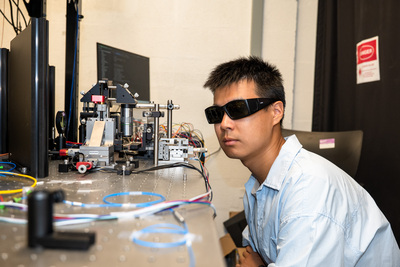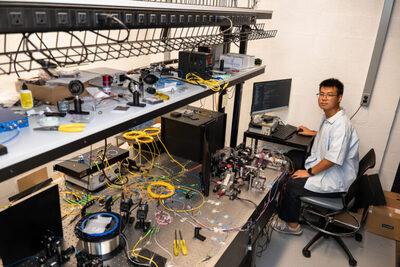Quantum signals sent with Standard Internet Protocol

Engineers at the University of Pennsylvania have brought quantum networking out of the lab and onto commercial fibre-optic cables using the same Internet Protocol (IP) that powers today’s web.
Reported in Science, the research shows that fragile quantum signals can run on the same infrastructure that carries everyday online traffic. The team tested their approach on Verizon’s campus fibre-optic network.
The Penn team’s ‘Q-Chip’ coordinates quantum and classical data and speaks the same language as the modern web. That approach could pave the way for a future ‘quantum internet’, which scientists believe may one day be as transformative as the dawn of the online era.
Quantum signals rely on pairs of ‘entangled’ particles, so closely linked that changing one instantly affects the other. Harnessing that property could allow quantum computers to link up and pool their processing power, enabling advances like faster, more energy-efficient AI or designing new drugs and materials beyond the reach of today’s supercomputers.
Penn’s work shows that a chip can not only send quantum signals but also automatically correct for noise, bundle quantum and classical data into standard internet-style packets, and route them using the same addressing system and management tools that connect everyday devices online.
“By showing an integrated chip can manage quantum signals on a live commercial network like Verizon’s, and do so using the same protocols that run the classical internet, we’ve taken a key step toward larger-scale experiments and a practical quantum internet,” said Liang Feng, professor in Materials Science and Engineering (MSE) and in Electrical and Systems Engineering (ESE), and the Science paper’s senior author.
The challenges of scaling the quantum internet
Erwin Schrodinger, who coined the term ‘quantum entanglement’, famously related the concept of a cat hidden in a box. If the lid is closed, and the box also contains radioactive material, the cat could be alive or dead. One way to interpret the situation is that the cat is both alive and dead. Only opening the box confirms the cat’s state.
That paradox is roughly analogous to the unique nature of quantum particles. Once measured, they lose their unusual properties, which makes scaling a quantum network extremely difficult.
“Normal networks measure data to guide it towards the ultimate destination,” said Robert Broberg, a doctoral student in ESE and co-author of the paper. “With purely quantum networks, you can’t do that, because measuring the particles destroys the quantum state.”
Coordinating classical and quantum signals
To get around this obstacle, the team developed the Q-Chip (short for Quantum-Classical Hybrid Internet by Photonics) to coordinate ‘classical’ signals, made of regular streams of light, and quantum particles. “The classical signal travels just ahead of the quantum signal,” said Yichi Zhang, a doctoral student in MSE and the paper’s first author. “That allows us to measure the classical signal for routing, while leaving the quantum signal intact.”
In essence, the new system works like a railway, pairing regular light locomotives with quantum cargo. “The classical ‘header’ acts like the train’s engine, while the quantum information rides behind in sealed containers,” Zhang said. “You can’t open the containers without destroying what’s inside, but the engine ensures the whole train gets where it needs to go.”
Because the classical header can be measured, the entire system can follow the same ‘IP’ or ‘Internet Protocol’ that governs today’s internet traffic. “By embedding quantum information in the familiar IP framework, we showed that a quantum internet could literally speak the same language as the classical one. That compatibility is key to scaling using existing infrastructure,” Zhang said.
Adapting quantum technology to the real world
One of the greatest challenges to transmitting quantum particles on commercial infrastructure is the variability of real-world transmission lines. Unlike laboratory environments, which can maintain ideal conditions, commercial networks frequently encounter changes in temperature, thanks to weather, as well as vibrations from human activities like construction and transportation, not to mention seismic activity.
To counteract this, the researchers developed an error-correction method that takes advantage of the fact that interference to the classical header will affect the quantum signal in a similar fashion. “Because we can measure the classical signal without damaging the quantum one, we can infer what corrections need to be made to the quantum signal without ever measuring it, preserving the quantum state,” Feng said.
In testing, the system maintained transmission fidelities above 97%, showing that it could overcome the noise and instability that usually destroy quantum signals outside the lab. And because the chip is made of silicon and fabricated using established techniques, it could be mass produced, making the new approach easy to scale.
“Our network has just one server and one node, connecting two buildings, with about a kilometre of fibre-optic cable installed by Verizon between them. But all you need to do to expand the network is fabricate more chips and connect them to Philadelphia’s existing fibre-optic cables,” Feng said.
The future of the quantum internet
The main barrier to scaling quantum networks beyond a metro area is that quantum signals cannot yet be amplified without destroying their entanglement.
While some teams have shown that ‘quantum keys’, special codes for ultra-secure communication, can travel long distances over ordinary fibre, those systems use weak coherent light to generate random numbers that cannot be copied, a technique highly effective for security applications but not sufficient to link actual quantum processors.
Overcoming this challenge will require new devices, but the Penn study provides an important early step: showing how a chip can run quantum signals over existing commercial fibre using internet-style packet routing, dynamic switching and on-chip error mitigation that work with the same protocols that manage today’s networks.
“This feels like the early days of the classical internet in the 1990s, when universities first connected their networks; that opened the door to transformations no one could have predicted. A quantum internet has the same potential,” Broberg said.
Transforming acoustic waves with a chip
Researchers have developed a chip that uses on-chip phased interdigital metamaterials to shape...
Mechanical strain boosts lead-free ferroelectrics
Scientists have discovered a way to boost the performance of lead-free ferroelectrics using pure...
Crypto chip keeps water flowing in rural communities
Twisthink has integrated Microchip's ATECC608B crypto chip into an IoT pump sensor, to...







